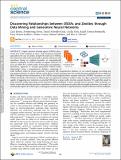Discovering Relationships between OSDAs and Zeolites through Data Mining and Generative Neural Networks
Author(s)
Jensen, Zach; Kwon, Soonhyoung; Schwalbe-Koda, Daniel; Paris, Cecilia; Gómez-Bombarelli, Rafael; Román-Leshkov, Yuriy; Corma, Avelino; Moliner, Manuel; Olivetti, Elsa A; ... Show more Show less
DownloadPublished version (2.738Mb)
Publisher with Creative Commons License
Publisher with Creative Commons License
Creative Commons Attribution
Terms of use
Metadata
Show full item recordAbstract
Organic structure directing agents (OSDAs) play a crucial role in the synthesis of micro- and mesoporous materials especially in the case of zeolites. Despite the wide use of OSDAs, their interaction with zeolite frameworks is poorly understood, with researchers relying on synthesis heuristics or computationally expensive techniques to predict whether an organic molecule can act as an OSDA for a certain zeolite. In this paper, we undertake a data-driven approach to unearth generalized OSDA-zeolite relationships using a comprehensive database comprising of 5,663 synthesis routes for porous materials. To generate this comprehensive database, we use natural language processing and text mining techniques to extract OSDAs, zeolite phases, and gel chemistry from the scientific literature published between 1966 and 2020. Through structural featurization of the OSDAs using weighted holistic invariant molecular (WHIM) descriptors, we relate OSDAs described in the literature to different types of cage-based, small-pore zeolites. Lastly, we adapt a generative neural network capable of suggesting new molecules as potential OSDAs for a given zeolite structure and gel chemistry. We apply this model to CHA and SFW zeolites generating several alternative OSDA candidates to those currently used in practice. These molecules are further vetted with molecular mechanics simulations to show the model generates physically meaningful predictions. Our model can automatically explore the OSDA space, reducing the amount of simulation or experimentation needed to find new OSDA candidates.
Date issued
2021Department
Massachusetts Institute of Technology. Department of Materials Science and Engineering; Massachusetts Institute of Technology. Department of Chemical EngineeringJournal
ACS Central Science
Publisher
American Chemical Society (ACS)